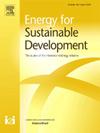Power sector transition plan of a coal-rich region in India with high-resolution spatio-temporal data based model
IF 4.4
2区 工程技术
Q2 ENERGY & FUELS
引用次数: 0
Abstract
This paper argues that a fit-for-purpose model and datasets are necessary to generate transition pathways for the electricity generation sector at the subnational level. We present the methodology, data, and results focusing at a sub-national level, the state of West Bengal in India. The approach can be generalized for any region with necessary customization. By utilizing high-resolution spatio-temporal input datasets, this study proposes a power sector capacity expansion model to compute three sets of transitional scenarios and one set of the current-as-usual scenario. These scenarios consider sub-national energy carrier-resource constraints and are solved to identify the most economically cost efficient future transition pathway for the electricity sector in West Bengal. Based on the least-cost solution, computations determine the optimal energy mix, operations, investments, and emissions for alternative scenarios. The results show that integrating demand-side flexibility (DSF) as a balancing option can lead to transformative outcomes. Compared to the current capacity expansion trend (ScenCA), adopting a thermal mix renewable scenario with intraday load-shifting (ScenTMDSF) could reduce 77% of emissions by 2040. This does not necessitate early retirement of existing thermal power plants, total investment increases by 13% compared to ScenCA. Without DSF as a balancing option, an additional 26% investment is required compared to the current-as-usual scenario for 2040. Transitioning to 100% renewable energy (ScenREN) requires 30% more investment, early retirement of 5.34 GW of thermal capacity, and nearly 2.7 times more storage battery capacity. These numbers help in understanding the magnitude of the financial resource and kind of technological need for the developing countries not only from the point of view of equitable climate action from burden sharing and just transition principles but also provides practical example of need for redirecting global capital for creating global good through subnational scale actions.
基于高分辨率时空数据模型的印度煤炭资源丰富地区电力部门转型计划
本文认为,要在国家以下层面生成发电行业的转型路径,必须要有适用的模型和数据集。我们以印度西孟加拉邦这一国家以下层面为重点,介绍了相关方法、数据和结果。只要进行必要的定制,该方法可推广到任何地区。通过利用高分辨率的时空输入数据集,本研究提出了一个电力行业产能扩张模型,以计算三组过渡情景和一组现状情景。这些方案考虑了国家以下各级的能源载体资源限制,并通过求解确定了西孟加拉邦电力部门最具经济成本效益的未来过渡途径。根据最低成本解决方案,计算确定了替代方案的最佳能源组合、运营、投资和排放。结果表明,将需求侧灵活性(DSF)作为一种平衡方案可带来变革性的结果。与当前的产能扩张趋势(ScenCA)相比,采用具有日内负荷转移功能的可再生热能组合方案(ScenTMDSF)可在 2040 年前减少 77% 的二氧化碳排放量。这并不需要提前淘汰现有的火力发电厂,与 ScenCA 相比,总投资增加了 13%。如果不采用 DSF 作为平衡方案,与 2040 年的 "一切照旧 "情景相比,需要增加 26% 的投资。过渡到 100% 可再生能源(ScenREN)需要增加 30% 的投资,提前退役 5.34 GW 的火力发电容量,以及增加近 2.7 倍的蓄电池容量。这些数字不仅有助于从责任分担和公正过渡原则的公平气候行动的角度来理解发展中国家的财政资源规模和技术需求种类,而且还提供了一个实际例子,说明需要通过国家以下规模的行动来重新引导全球资本,以创造全球福祉。
本文章由计算机程序翻译,如有差异,请以英文原文为准。
求助全文
约1分钟内获得全文
求助全文
来源期刊

Energy for Sustainable Development
ENERGY & FUELS-ENERGY & FUELS
CiteScore
8.10
自引率
9.10%
发文量
187
审稿时长
6-12 weeks
期刊介绍:
Published on behalf of the International Energy Initiative, Energy for Sustainable Development is the journal for decision makers, managers, consultants, policy makers, planners and researchers in both government and non-government organizations. It publishes original research and reviews about energy in developing countries, sustainable development, energy resources, technologies, policies and interactions.
 求助内容:
求助内容: 应助结果提醒方式:
应助结果提醒方式:


